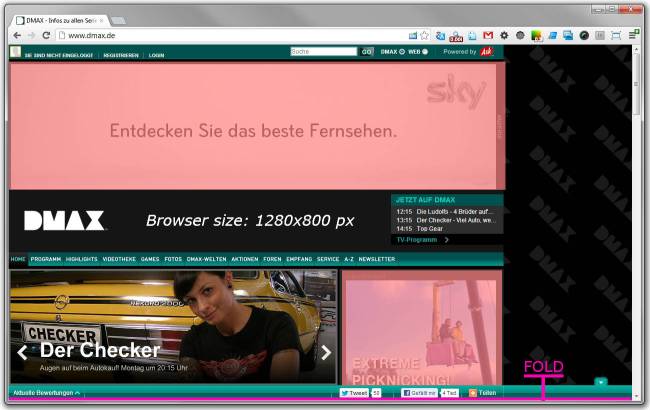Above the Fold advertisements have varying effects depending on the display resolution and the resulting relationship between immediately visible content and advertisements. Many websites (and/or their ad formats) are still not optimised for different “lower” display resolutions, as well as being shown on tablets, or even (sub-) notebooks.
Delivering the same banner sizes regardless of the visitors monitor resolution, might very well have a negative effect on the user experience of your website:
Example #1 homepage of dmax.de
The website dmax.de adds a large 185px advertisement banner to the top of their page. The size as well as the positioning of the ad, at the common display resolution of 1280×800 pixel of a 15.4″ notebook, have a negative influence on the user experience – as well as the display/content ratio for the immediately visible area of the page.
Example #2 homepage and article page of t3n.de
As a comparison to the above example, here we wave both the homepage and an article page of t3n.de – shown on a sub-notebook with a 13.3″ display and a resolution of 1366×768 pixel:
On the homepage of t3n.de (left image), the actual content is almost pushed to the invisible area, at a monitor resolution of 1366×768 pixel. The two big advertisement blocks dominate the visual field for the user. On the article page (right image), on the other hand, the focus is on the content which is well “above the fold”.
- (“above the fold” is an expression that originated from the printing profession and, online, describes the visible area of a website that appears on the monitor without the user having to scroll down.)
What is harmful and what is not?
Generally, using big advertisement blocks, even in the immediately visible area of a website, is not harmful. Although it should be kept in mind that the ratio of ads to content should be in favour of the content “above the fold”, when you take all the pages on your site into consideration. Otherwise, you are at risk of being hit by one of Google’s algorithmic penalties, as the Page Layout Algorithm rates the relationship between content and ads of the immediately visible area on a website.
Nowadays, a website should offer a good user experience for almost all monitor resolutions. Techniques like “responsive web design” and “mobile display formats” can be helpful.

